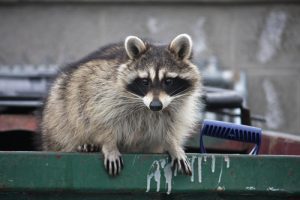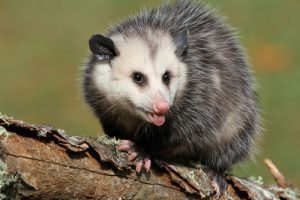How Not to Attract Raccoons and Opossums! – Advice From the Pros
By Chris Williams on January 26, 2012.
Raccoons and opossums are two of the most common wildlife invaders in urban and suburban yards and homes. They don’t just end up there accidentally. There are plenty of things we humans do that provide food and shelter for wild animals. Below are just some of the conditions that can attract raccoons and opossums to your property, listed in alphabetical order:
 1) Access under building – Accessible crawlspaces under buildings and trailers provide denning sites and hiding places during the day.
1) Access under building – Accessible crawlspaces under buildings and trailers provide denning sites and hiding places during the day.
2) Berries – Berries on low bushes or on the ground provide food, primarily in late summer and in the fall.
3) Branch piles/debris – Branch or debris piles can be used as denning sites.
4) Burrows – Abandoned woodchuck (groundhog) burrows and rodent burrows on your property may be re-used as denning sites for other animal invaders.
5) Compost piles – If they contain vegetables and other foods, compost piles will attract raccoons and opossums.
6) Fascia/soffit damage – Nuisance wildlife can gain access to attics through damaged fascia boards and sophist.
7) Fruit trees – Fallen fruit on the ground and ripe fruit remaining in trees provides attractive food for nuisance wildlife, especially in late summer and fall.
8) Missing/damaged chimney cap – Raccoons, especially, commonly enter accessible chimneys to rest during the day, and on occasion will use a chimney as a denning site, particularly in spring.
9) Nut trees – Raccoons feed on nuts, primarily in late summer and fall.
10) Open dumpster – Animals will crawl into dumpsters to reach food.
11) Overgrown plants/weeds – These provide shelter and cover for wildlife foraging for food near occupied areas, and also contribute to wildlife nesting near buildings.
12) Shrubbery against buildings – Animals can travel hidden in protected corridors between tall, thick shrubbery and building walls.
 13) Siding damage – Raccoons and opossums can gain access to crawlspaces or attics through damaged siding.
13) Siding damage – Raccoons and opossums can gain access to crawlspaces or attics through damaged siding.
14) Spilled bird seed – Seeds are high energy foods. Sunflower seeds, in particular, are a favorite food of raccoons and opossums, and these animals will often make bird feeders in the area a regular foraging stop.
15) Spilled trash – Human food in spilled trash around dumpsters, trash receptacles, picnic tables and the like can provide food for opossums and raccoons.
16) Stacked building materials – Opossums, and to a lesser extent, raccoons may use stacked building materials as a shelter or denning area.
17) Structural access made easy – Animals may gain access to buildings through damaged screens, holes in walls, missing vent covers, etc.
18) Trash receptacles that are not wildlife-proof – Open-topped trash receptacles, or those with lids not secured, provide easy access to food for raccoons and opossums.
Problems with nuisance wildlife? Call Colonial. We are the experts.